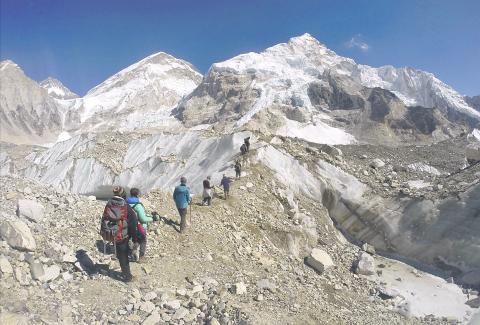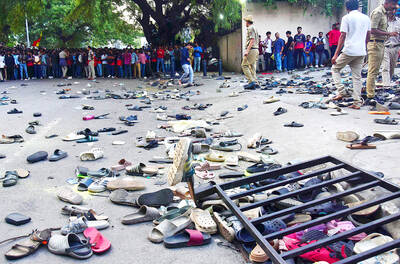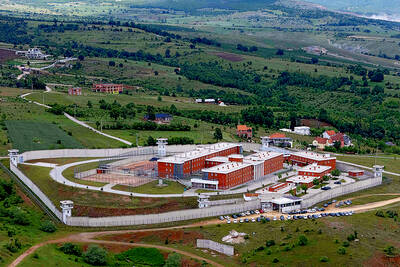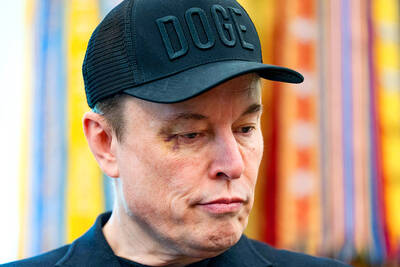About 30 climbers have developed frostbite or become sick near the summit of Mount Everest, a mountaineering official said yesterday, after two deaths from apparent altitude sickness in recent days highlighted the risks on the world’s highest mountain.
Most of the sick climbers suffered frostbite while attempting to reach the summit or on their descent, Mountaineering Department official Gyanendra Shrestha said.
Favorable weather has allowed about 400 climbers to reach the summit from Nepal since May 11, but the altitude, weather and harsh terrain can cause problems at any time.

Photo: AP
Several Sherpa guides carried one sick climber from the highest camp, at about 8,000m, to camp two, at 6,400m, where attempts are being made to pick her up with a helicopter, said Pemba Sherpa of the Seven Summit Treks agency in Kathmandu.
Seema Goshwami of India had frostbite to her hands and feet at the South Col camp and was unable to move.
“It took a big and risky effort, but we were able to save her,” Sherpa said, adding that an Iranian climber identified only as S. Hadi had been brought to Kathmandu and was recovering in a hospital.
A Norwegian woman, 45-year-old Siv Harstad, suffered snow blindness and was helped down from the summit on Saturday, the Norwegian news agency NTB said.
The two climbers who died were on the same expedition team. It was undecided when and if their bodies would be brought down from the high altitude and it would depend on the team and family members, Pasang Phurba of the Seven Summits agency said.
Carrying bodies down Everest takes at least eight Sherpas since they become frozen and heavier than normal.
More details were not available because of communication difficulties on the 8,850m mountain.
The two deaths were the first confirmed this year on Everest, during a busy climbing season that follows two years in which the peak was virtually empty due to two fatal avalanches.
Eric Arnold, 35, had enough bottled oxygen with him, as well as climbing partners, but he complained of getting weak and died on Friday night near South Col before he was able to get to a lower altitude, Phurba said.
Just hours after Arnold died, Australian climber Maria Strydom also showed signs of altitude sickness on Saturday afternoon before she died, Phurba said.
Strydom was a finance lecturer at Monash University’s business school in Melbourne. The school posted on Facebook that the community was deeply saddened by her death.
Arnold was from Rotterdam, according to his Twitter account, which was updated on Friday with a post that he had reached the summit on his fifth try.
In an interview earlier this year with RTV Rijnmond, Arnold said that the risks of climbing the world’s highest peak did not end at the summit.
“Two-thirds of the accidents happen on the way down,” he said. “If you get euphoric and think ‘I have reached my goal,’ the most dangerous part is still ahead of you.”
Strydom and her husband were attempting to climb the seven summits, the highest peaks on the seven continents, according to the Monash Business School’s Web site.
She had already climbed Denali in Alaska, Aconcagua in Argentina, Mount Ararat in Turkey and Kilamanjaro in Kenya, the Web site said.
Strydom said she felt well-prepared for her attempt to climb Everest and that depending on whether she reached the summit, her mind would likely turn to her next adventure.
Thousands of people have summited Mount Everest since it was first conquered by New Zealander Edmund Hillary and Sherpa Tenzing Norgay in 1953.
However, more than 250 people have died in the attempt.
Trekking companies were anxious to see foreign climbers return after two years of disasters. The devastating earthquake last year caused the season to be canceled and climbing attempts were largely abandoned in 2014 after an avalanche above the base camp killed 16 Sherpa guides.

Packed crowds in India celebrating their cricket team’s victory ended in a deadly stampede on Wednesday, with 11 mainly young fans crushed to death, the local state’s chief minister said. Joyous cricket fans had come out to celebrate and welcome home their heroes, Royal Challengers Bengaluru, after they beat Punjab Kings in a roller-coaster Indian Premier League (IPL) cricket final on Tuesday night. However, the euphoria of the vast crowds in the southern tech city of Bengaluru ended in disaster, with Indian Prime Minister Narendra calling it “absolutely heartrending.” Karnataka Chief Minister Siddaramaiah said most of the deceased are young, with 11 dead

By 2027, Denmark would relocate its foreign convicts to a prison in Kosovo under a 200-million-euro (US$228.6 million) agreement that has raised concerns among non-governmental organizations (NGOs) and residents, but which could serve as a model for the rest of the EU. The agreement, reached in 2022 and ratified by Kosovar lawmakers last year, provides for the reception of up to 300 foreign prisoners sentenced in Denmark. They must not have been convicted of terrorism or war crimes, or have a mental condition or terminal disease. Once their sentence is completed in Kosovan, they would be deported to their home country. In

DENIAL: Musk said that the ‘New York Times was lying their ass off,’ after it reported he used so much drugs that he developed bladder problems Elon Musk on Saturday denied a report that he used ketamine and other drugs extensively last year on the US presidential campaign trail. The New York Times on Friday reported that the billionaire adviser to US President Donald Trump used so much ketamine, a powerful anesthetic, that he developed bladder problems. The newspaper said the world’s richest person also took ecstasy and mushrooms, and traveled with a pill box last year, adding that it was not known whether Musk also took drugs while heading the so-called US Department of Government Efficiency (DOGE) after Trump took power in January. In a

LOST CONTACT: The mission carried payloads from Japan, the US and Taiwan’s National Central University, including a deep space radiation probe, ispace said Japanese company ispace said its uncrewed moon lander likely crashed onto the moon’s surface during its lunar touchdown attempt yesterday, marking another failure two years after its unsuccessful inaugural mission. Tokyo-based ispace had hoped to join US firms Intuitive Machines and Firefly Aerospace as companies that have accomplished commercial landings amid a global race for the moon, which includes state-run missions from China and India. A successful mission would have made ispace the first company outside the US to achieve a moon landing. Resilience, ispace’s second lunar lander, could not decelerate fast enough as it approached the moon, and the company has